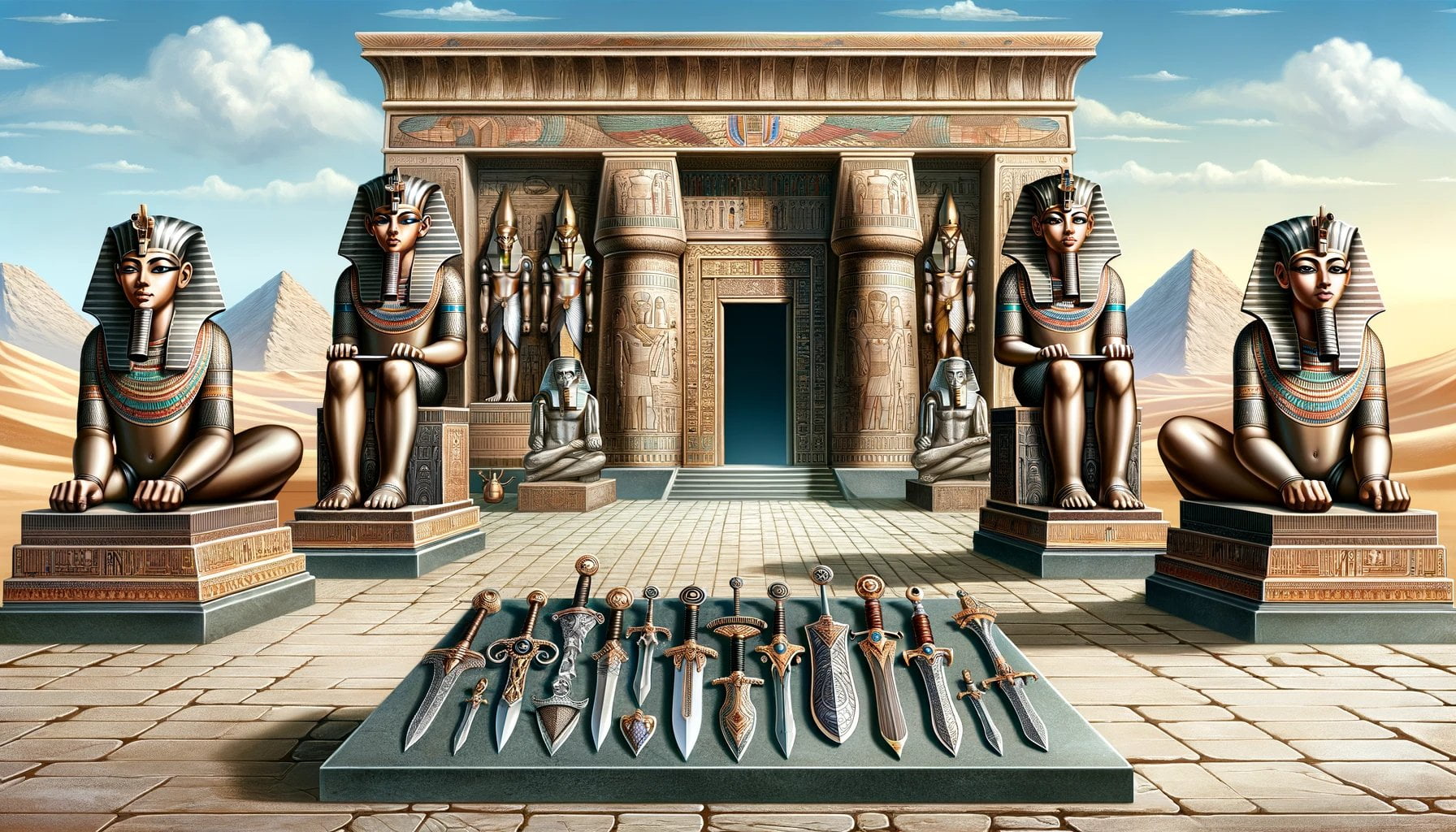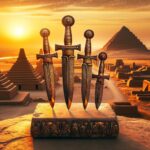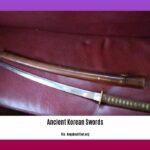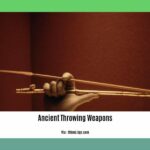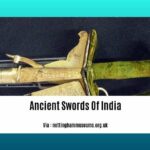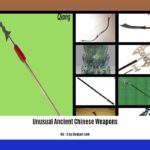Unveiling Ancient Egypt’s Swords: History, Symbolism, and Significance delves into the captivating realm of Ancient Egypt, shedding light on the enigmatic swords that once graced this civilization. As we explore the rich history, symbolism, and deep-rooted significance behind these weapons, we unlock a hidden world of craftsmanship, cultural importance, and technological advancements. From their intricate designs to their profound role in ancient warfare, join us on a captivating journey through the secrets of Ancient Egypt’s swords.
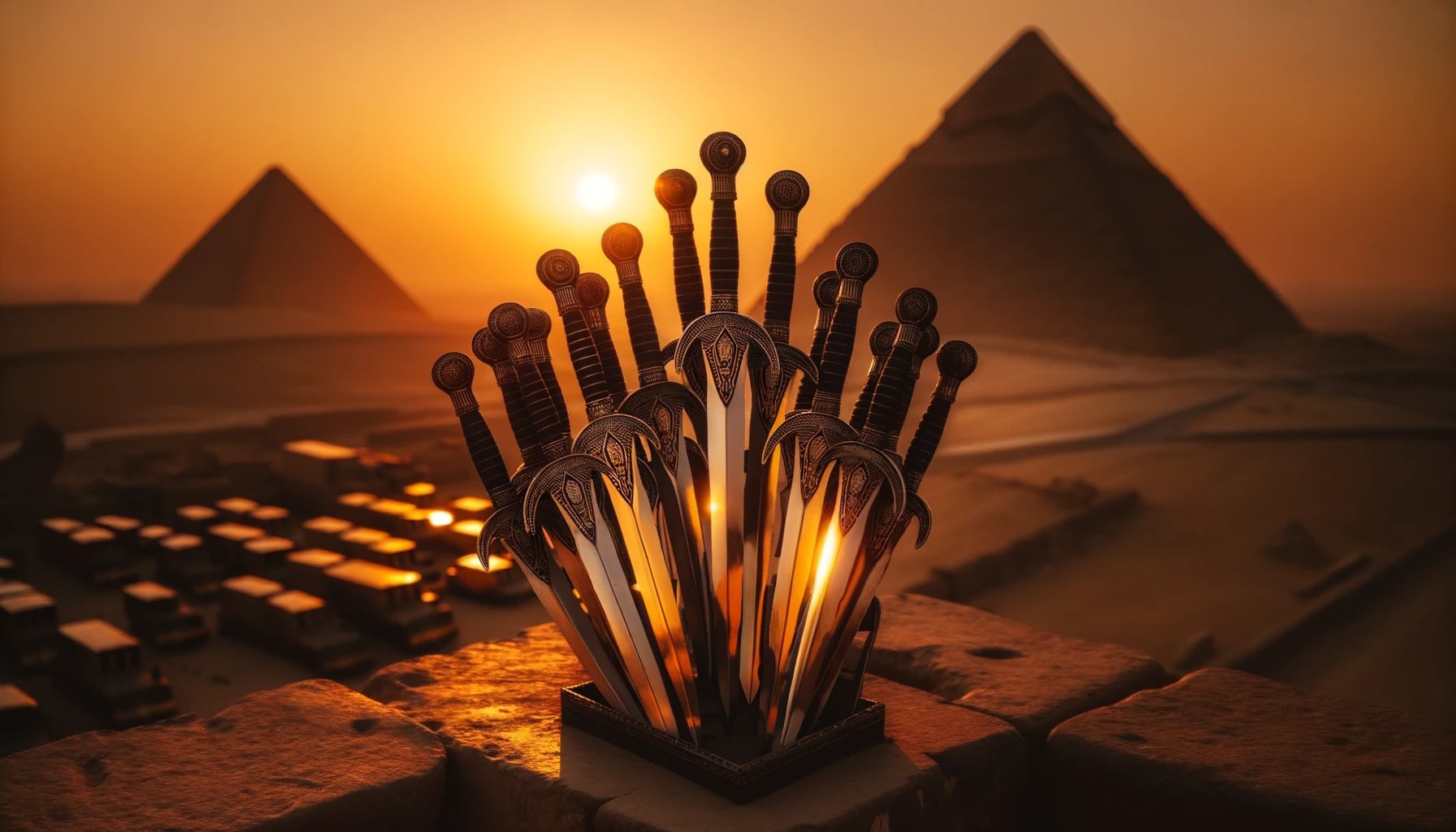
Key Takeaways:
- The khopesh is a curved sword or saber used in ancient Egypt and the Near East.
- It evolved from axes used in warfare and was made of bronze, iron, or steel.
- The khopesh had a long cutting edge and a thick spine, and was used for slashing and hooking.
- It was a symbol of power and authority and was used by Egyptians to forge an empire.
- Other types of Egyptian swords include straight, two-edged blades.
- Egyptian swords were typically made of bronze, but later versions were made of iron and steel.
- Modern bladesmiths now craft khopesh swords from high carbon steel and other metals.
- The Egyptian army consisted of spearmen armed with a wooden shield and a bronze-tipped spear.
- They also used javelins, mace-axes, battle axes, and short swords.
- The javelin served as both a hand-launched missile and a short spear in close combat.
- The mace-ax was a distinctive Egyptian weapon, and the standard war mace was a bludgeoning club.
- Short swords became more common after the introduction of bronze casting technology by the Hyksos.
- The swords played an important role in battles and combat in ancient Egypt.
Ancient Egypt Swords
The ancient Egyptians were known for their mastery of swordmaking, creating weapons that were not only functional but also rich in symbolism and significance. One of the most iconic swords from ancient Egypt is the khopesh, a curved sword or saber that played a crucial role in their military campaigns and cultural identity.
The Khopesh: A Symbol of Power and Authority
The khopesh featured a unique curved blade in the shape of a “U” or sickle, evolved from axes used in warfare. Made of materials like bronze, iron, or steel, this sword had a long cutting edge and a thick spine, enabling it to be used for slashing and hooking maneuvers. Its distinctive shape made it both a practical weapon and a symbol of power and authority.
Evolution of Egyptian Swords
While the khopesh is perhaps the most well-known Egyptian sword, it’s essential to note that other types of swords were also prevalent in ancient Egypt. Straight, two-edged blades were also used, typically made of bronze. Initially, the khopesh itself was cast from bronze, but as technology advanced, later versions were crafted from iron and steel. In modern times, bladesmiths even create replica khopesh swords using high carbon steel and other metals.
Role in Ancient Egyptian Warfare
Swords played an essential role in battles and combat in ancient Egypt. The core of the Egyptian army consisted of spearmen armed with a wooden shield and a bronze-tipped spear. In addition to spears, the Egyptian army utilized a range of other weapons, including javelins, mace-axes, battle axes, and short swords.
The javelin served as both a hand-launched missile and a short spear in close combat. The mace-ax was a distinctive Egyptian weapon, with a bludgeoning club-like design. Meanwhile, the battle axe served as a secondary weapon used in close combat. It’s worth noting that the introduction of bronze casting technology by the Hyksos led to the increased prevalence of short swords in ancient Egyptian warfare.
Uncovering the History and Significance
Unveiling the history, symbolism, and significance of Ancient Egypt swords provides invaluable insights into this captivating civilization. These swords were not only tools of war but also representations of power, authority, and cultural identity. With each archaeological find, we gain a deeper understanding of the craftsmanship, technological advancements, and cultural contexts surrounding these remarkable weapons.
Conclusion
Ancient Egypt swords, particularly the iconic khopesh, stand as powerful symbols of power, authority, and the ancient Egyptian civilization as a whole. Through their design, materials, and role in warfare, these swords offer us a glimpse into the rich history, symbolism, and significance of this fascinating era. As we continue to uncover and analyze artifacts from ancient Egypt, we can shed further light on the achievements and cultural legacy of this remarkable civilization.
Ancient Temples of Egypt are a sight to behold. Explore the mystique and grandeur of these ancient structures by clicking here. Your journey through time awaits!
Significance of Ancient Egypt Swords in Warfare
The Significance of Ancient Egypt Swords in Warfare can be traced back to the crucial role they played in maintaining unity and stability in the country. While swords were not commonly used by ancient Egyptians before the Hyksos introduced advances in bronze casting technology, they became an important weapon during the New Kingdom and thereafter.
Evolution of Ancient Egyptian Weapons
Ancient Egyptian warfare evolved over time, with different periods introducing new weapons and tactics. In the Predynastic and Early Dynastic Periods, weapons such as maces, daggers, and spears were commonly used. The Old Kingdom saw the introduction of bows and arrows, while the Middle Kingdom witnessed the use of copper axes, swords, and bronze spears. The 13th Dynasty, ruled by the Hyksos, made significant contributions to Egyptian stability.
The Role of Swords in Ancient Egyptian Warfare
Swords, including the iconic khopesh, played a crucial role in ancient Egyptian warfare. Although not as technologically advanced as swords from other civilizations, the ancient Egyptians utilized swords alongside spears, javelins, mace-axes, and battle axes. The khopesh, with its distinctive “U” or sickle-shaped blade, was widely used among warriors in the ancient Near East.
The significance of ancient Egypt swords in warfare can be understood through their cultural importance and symbolism. These weapons represented power, authority, and cultural identity. They were renowned for their craftsmanship and served as functional weapons in battle.
Technological Advancements and Cultural Context
Advancements in bronze casting technology allowed for the production of more sophisticated swords in ancient Egypt. Short swords became more prevalent, providing warriors with greater mobility on the battlefield. The evolution of ancient Egyptian weapons can be traced from simple tools to the intricately designed khopesh sword.
Studying these ancient Egyptian swords provides valuable insights into the craftsmanship, technology, and cultural context of the civilization as a whole. Archaeological finds and analysis continue to shed light on their significance in warfare and their role in shaping ancient Egyptian society.
Key Takeaways:
- Ancient Egyptian warfare relied on a variety of weapons, including swords, to maintain stability and unity.
- Swords, such as the khopesh, played a significant role in ancient Egyptian warfare, alongside spears, javelins, and battle axes.
- The khopesh, with its distinctive sickle-shaped blade, was widely used and represented cultural identity and authority.
- Advancements in bronze casting technology allowed for the production of more sophisticated swords in ancient Egypt.
- Studying ancient Egypt swords provides insights into craftsmanship, technology, and the cultural context of the civilization.
Technological Advancements in Ancient Egypt Swordmaking
Ancient Egypt was a civilization known for its remarkable technological advancements and innovations. From medicine to construction, the ancient Egyptians showcased their expertise in various fields. One area where their technological prowess was particularly evident was in swordmaking. In this article, we will delve into the technological advancements achieved by the ancient Egyptians in the art of crafting swords.
The Evolution of Swordmaking Techniques
The ancient Egyptians utilized their extensive knowledge in metallurgy to develop advanced techniques for creating swords. They experimented with various materials, including bronze, iron, and steel, to enhance the strength and durability of their weapons.
The casting of bronze played a crucial role in the evolution of ancient Egyptian swordmaking. [Technological Advancements in Ancient Egypt Swordmaking] allowed them to produce more sophisticated swords with intricate designs and improved functionality. Bronze swords were favored for their ability to hold a sharp edge and withstand the rigors of battle.
Innovations in Sword Designs
With advancements in technology, the ancient Egyptians also introduced innovations in sword designs. One such iconic sword was the khopesh, a curved sword or saber with a unique “U” or sickle-shaped blade. The [Technological Advancements in Ancient Egypt Swordmaking] enabled craftsmen to create khopesh swords with a long cutting edge and a thick spine, making them ideal for slashing and hooking maneuvers.
In addition to the khopesh, ancient Egyptians also utilized straight, two-edged swords made of bronze. These swords were simpler in design but were equally effective in combat. The [Technological Advancements in Ancient Egypt Swordmaking] led to the refinement of the sword’s shape and balance, making them more versatile and deadly in the hands of skilled warriors.
The Significance of Technological Advancements
The advancement in swordmaking technology had a significant impact on ancient Egyptian warfare. These swords symbolized power, authority, and cultural identity for the Egyptians. With the introduction of more sophisticated swords, the Egyptian military gained an edge over their adversaries, ensuring the unity and stability of the country.
The [Technological Advancements in Ancient Egypt Swordmaking] not only improved the functionality of the swords but also showcased the craftsmanship and ingenuity of the ancient Egyptians. The intricate designs and inscriptions found on these swords provide valuable insights into the cultural context of the civilization as a whole.
Key Takeaways:
- Ancient Egypt witnessed significant technological advancements in swordmaking, leading to the production of more sophisticated weapons.
- The casting of bronze played a crucial role in enhancing the strength and durability of Egyptian swords.
- The introduction of the iconic khopesh sword, with its unique sickle-shaped blade, was a remarkable innovation in ancient Egyptian sword designs.
- Bronze swords and straight, two-edged swords were widely used in ancient Egyptian warfare.
- The technological advancements in ancient Egypt swordmaking not only improved the functionality of the weapons but also represented power, authority, and cultural identity.
- The craftsmanship and intricate designs found on these swords provide valuable insights into the ancient Egyptian civilization as a whole.
Historical Context of Ancient Egypt Swords
Key Takeaways:
– Ancient Egyptian swords were introduced during the New Kingdom in Egypt.
– Swords and daggers were not commonly used by the Ancient Egyptians until the Hyksos introduced advancements in bronze casting technology.
– The khopesh, a curved sword with a “U” or sickle-shaped blade, served as a symbol of strength and royal power in ancient Egypt.
– Egyptian swords lacked joints in the hilt and blade, making them more durable.
– Khopesh swords were commonly depicted in the hands of Egyptian pharaohs and soldiers in ceremonial roles.
Ancient Egypt, known for its rich history and remarkable civilization, also holds fascinating insights into the weaponry employed by its ancient warriors. When exploring the historical context surrounding Ancient Egypt swords, it becomes apparent that swords and daggers were not commonly used by the Egyptians until the introduction of advancements in bronze casting technology.
During the early years of ancient Egypt, basic daggers, spears, and maces were the primary weapons employed in warfare. However, as the New Kingdom emerged, advancements in bronze casting technology allowed for the casting of whole swords in ancient Egypt. One of the most iconic swords that emerged during this period was the khopesh.
The khopesh possessed a unique curved blade in the shape of a “U” or a sickle, which set it apart from other swords of the time. It not only served as a functional weapon but also carried great symbolic significance. The khopesh was revered as a symbol of strength and royal power in ancient Egypt, often wielded by pharaohs and soldiers in ceremonial roles.
One notable advantage of Egyptian swords was their durability. Unlike other swords that featured joints in the hilt and blade, ancient Egyptian swords lacked these weak points, making them more resistant to damage and ensuring their longevity.
Even though Egyptian swords were not considered superior to those invented in other places, they played a vital role in ancient Egyptian warfare. Alongside spears, javelins, mace-axes, and battle axes, swords served as important weapons in maintaining unity and stability in the country.
Unraveling the historical context of Ancient Egypt swords offers valuable insights into the craftsmanship, technology, and cultural identity of this fascinating civilization. Through the study of archaeological finds, analysis of ancient scripts, and collaboration with fellow experts, researchers have been able to shed light on the significance of these remarkable weapons from the past.
In conclusion, the historical context of Ancient Egypt swords reveals their importance in ancient Egyptian warfare and their symbolic value in terms of power, authority, and cultural identity. By delving into the craftsmanship, technology, and cultural context of these swords, we gain a deeper understanding of the ancient Egyptian civilization as a whole.
References:
Ancient Egypt. (n.d.). https://education.nationalgeographic.org/resource/resource-library-ancient-egypt/
Bowman, A. K., Wente, E. F., Dorman, P. F., Samuel, A. E., & Baines, J. R. (2023, September 30). Ancient Egypt | History, Government, Culture, Map, & Facts. Encyclopedia Britannica. https://www.britannica.com/place/ancient-Egypt
Ancient Egypt. (2023, September 27). Wikipedia. https://en.wikipedia.org/wiki/Ancient_Egypt

FAQ
Q1: What is the khopesh sword?
A1: The khopesh sword is a curved sword or saber used in ancient Egypt and the Near East. It has a curved blade in the shape of a “U” or sickle and evolved from axes used in warfare.
Q2: What materials were ancient Egyptian swords made of?
A2: Ancient Egyptian swords were typically made of metal, specifically bronze. The khopesh was initially cast from bronze, while later versions were made of iron and steel. Modern bladesmiths now craft khopesh swords from high carbon steel and other metals.
Q3: How were ancient Egyptian swords used in combat?
A3: Ancient Egyptian swords, including the khopesh, were primarily used for slashing and hooking in close combat. They had a long cutting edge and a thick spine. The swords played an important role in battles and combat in ancient Egypt.
Q4: Were ancient Egyptian swords inferior to swords from other regions?
A4: Yes, ancient Egyptian swords were considered inferior to swords invented in other places. Swords and daggers were not common Egyptian weapons before the Hyksos introduced advances in bronze casting technology.
Q5: What significance did the khopesh sword hold in ancient Egypt?
A5: The khopesh sword served as a symbol of strength and royal power in ancient Egypt. It was also associated with authority and was used by Egyptians to forge and maintain their empire.
